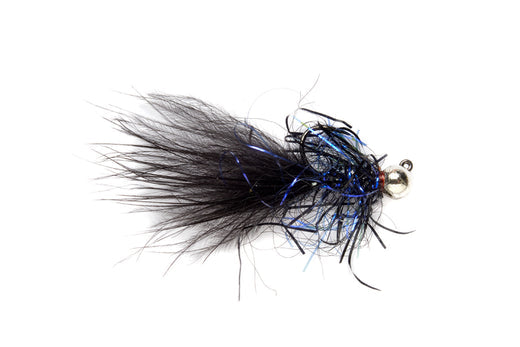Over the next three months, we’re going to do a series of flies for stillwater trout tied on jig hooks: a streamer, nymph, and balanced leech. An introduction to patterns uniquely tied and fished that will surpass expectations in terms of effectiveness, starting with the Fulling Mill Weiss' UV Jig Bugger
We’ve been fishing this streamer on the Ash River for quite some time now, and it has proven very effective. Tied with a heavy tungsten bead, the movement generated by the weight and the placement of the bead on the hook, you’re left with a fly that dips quickly in the water. Depending on your retrieve, the fly will jig up and down in the water on every strip, the dipping motion will add more movement to the marabou tail than a regular streamer tied similarly. Of course, the fly will also ride hook up, which reduces snags in a river.
"Hopping/jigging action is key with this pattern. Can be stripped and dead-drifted with equal success. A great sculpin/crayfish action without the nonsense of many streamers out there today" - Pat Weiss"

Now, when it comes to fishing for trout in a stillwater, few people opt for flies tied on jig hooks. It’s a relatively new concept, but there are definite advantages. When it comes to a nymph tied on a jig hook, the way your fly suspends is more natural. Rather than having the bend of the hook tilt the back of your fly down, generally having your fly sit at a 45-degree angle pointed upwards when fished static. When it comes to streamers, you can either opt for a heavier bead to achieve more movement, or you can tie a balanced fly. This incorporates a pin and counter sunk bead, ensuring your fly suspends level in the water.
The Weiss UV Bugger won’t be our first fly we cast in winter, we’ll always opt for a less impactful approach such as a nymph suspended under an indicator or possibly a dry and dropper in the shallows; always keeping an eye out for cruising fish in the margins. However, when size 18 nymphs don’t do the trick, it’s time to pull out the sinking line, step up your tippet to 3X or 4X, and tie on a bugger. The advantage of this pattern, in combination with the heavy bead, is the flashy UV struggle chenille used for the body. This will push water and attract fish from far off. Sometimes trout are not actively feeding, such is the case more often than not in winter. Spawning behavior can be very frustrating for us fishermen, so tying on a bugger and employing a more aggressive retrieve might just do the trick and turn a couple heads, resulting in one or two additional fish for the day.
When fishing a river, depending on the flow, consider adding a poly leader to help get your jig bugger down to the right depth and stay there for longer making your swing more effective.
For the tyers out there, we have introduced a range of Fulling Mill materials this month, including the UV Straggle chenille required to tie this pattern, take a look and fill up your box with what might just be your new favorite streamer.

